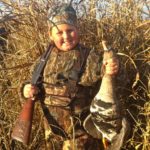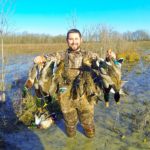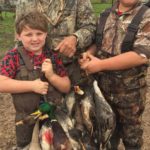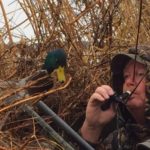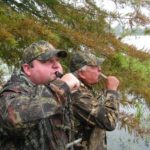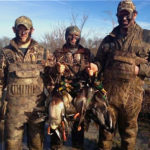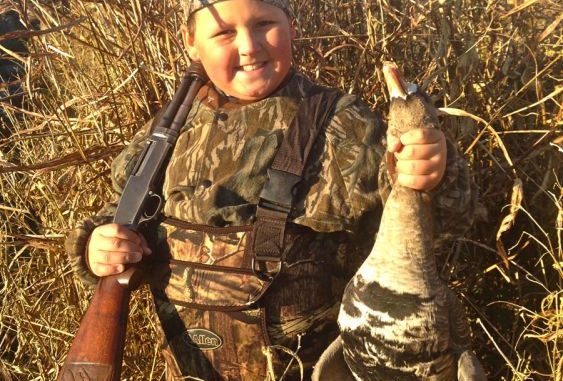
Duck hunting is in this family’s DNA, so they know how to fill their limits. And now they’re helping others do the same. Here are some of their tricks to North Louisiana waterfowling success.
Archer Daniels looked up at the ducks, grabbed the Haydel duck call and blew hard as he could.
Then, bam bam — he unloaded on a couple of big mallards, which evoked a big smile and a chuckle.
He was obviously hooked on duck hunting.
The funny thing about that story is that Archer was 20 months old. He was blowing the calls that belong to his dad, Colby, and he was shooting a toy gun at the mallards mounted up on the living room wall.
“He’s hilarious, but he is already eaten up with it,” the elder Daniels said.
He has to be: It’s a family tradition.
Colby Daniels is now 36 years old, and he learned from his father Davy at an early age, and killed his first mallard at 5 years of age.
Davy Daniels did the same thing “a hundred years earlier” with his dad.
That love of waterfowling and the fact that they live and farm in an area that is one of the top duck and goose areas in America has led them to also take hundreds of other hunters each year.
Since 1990, they have operated and served as head guides for Top Gun Guides eight miles northeast of Mer Rouge on the edge of Northeast Louisiana’s Little Missouri.
“We are blessed to live in the heart of the Mississippi flyway, and in a good year there are literally millions of ducks and geese migrating through this region,” Davy said. “We had been taking people hunting for 20 years and not charging before we formed Top Gun. It just got so big and expensive we had to do something different.
“We set up the guide service, started advertising and by word of mouth, (and)we have hunts booked almost every day of the season now.”
Whether you go on a guided duck hunt with someone like the Daniels or just hunt on your own, you can learn a lot from what these duck-hunting fanatics have to say. In fact, some hunters go on guided trips not just to kill ducks but to learn all they can for when they hunt on their own.
One of the most rewarding and interesting things about being a duck guide is the people you meet, the Daniels said.
“We have people as young as 6 or 7, and we have one client who comes every year who is well up in his 90s,” Colby said. “The kids just want to kill a bunch of ducks, and the older hunters just want to have a good time.
“We try to do both.”
Guided hunts are much like regular hunts in a couple of major ways. First, if you aren’t ready when you get to the blind, you won’t do much good. You need to practice shooting doves or skeet or getting in some sort of practice with the gun and shells you will duck hunt with.
Feeling comfortable with your gun and shooting ability is important, Davy said.
Second, you have be camouflaged from head to tie and wear comfortable clothing to fit the elements, from rain to cold to heat. So check the weather before the hunt — and then be prepared for anything.
The Daniels also recommended shooting 12-gauge shotguns with BB or No. 1 shot. The heavier the load, the more successful you will be, especially in the fields, the explained.
“We had a client come one day with a 20-gauge and 2¾-inch shells,” Davy Daniels said. “The wind was howling in from the north, and we had 100 ducks locking up over the decoy spread.
“He jumped up and shot, and they didn’t even know he was there.”
One group that is learning how to be top guns from a young age are Colby’s kids. Besides Archer, there are brothers Drake, Fisher and Chris, along with daughter Kennedy.
“There is nothing you can do better for your kids than to expose them to hunting,” Colby Daniels said. “My kids don’t spend hours on video games or going to the movies — they love to hunt, just go shoot or do something outdoors.”
Ducks are the main draw to the area, but the thousands of specklebelly geese that spend the whole season here are a special bonus.
Some hunters even prefer geese over ducks: They are, after all, easier to hit.
Even though the Daniels have set blinds, they also know there comes a time you have to move. So they are set up to move to different spots in the fields, get in a boat blind in the brakes or even wade and hide in the standing timber if that’s where the ducks want to go.
“Ducks pretty much go to the same areas in this flyway year after year,” Davy Daniel said. “They have spots and holes that are just natural to them. It’s the same anywhere you hunt. Knowing where those areas are is really important.”
But don’t get too locked in.
“Floods, ice storms and early season hot weather can change that, so you have to be flexible,” Davy said. “Those three things are the worst things we can have duck hunting.”
When it comes to duck hunting and decoy spreads, hunters usually have more varying opinions than candidates for national political office.
But Davy and Colby have their decoy platform pretty well set from year to year.
“We have tried everything from sizes and shapes of spreads to taking decoys up every day and leaving them out ever day,” Colby said. “What we do now is just put the decoys out a couple of days before the season opens and we leave them out the entire season.
“Later on in the season when they get a little gun shy, we reduce the numbers, but that is about it.”
At Top Gun, they keep six to eight blinds operating all the time, and they start each season with a big X pattern of decoys with the blind in the center. They put a V pattern in front of the blind and a V pattern behind the blind.
Each spread has up to 200 decoys per blind.
They don’t believe in having bright, new decoys all the time. In fact, Davy is old school, and the rougher the decoy looks, the happier he is.
They also don’t use a lot of motorized decoys because, while they do sometimes help with ducks, specklebelly geese don’t seem to like them.
They do use a variety of decoy types from mallards to pintails and teal.
“There is one thing that we do totally believe in,” Davy said. “We use a lot of decoys on pull strings and make sure that if there is no wind we have some way to put as much ripple on the water as possible.
“That’s very important.”
If there is one other important lesson they have learned over the years, it is that no matter what you do, the ducks won’t play if they don’t want to.
“If you are where the ducks want to come, it doesn’t really matter what your call sounds like or what your decoy spread looks like,” Colby said. “If they want to come, they will come. On the other hand, if you are somewhere they don’t want to come for some reason, you can be the best caller in the world and have 50,000 decoys — forget it.
“They are not coming in.”
